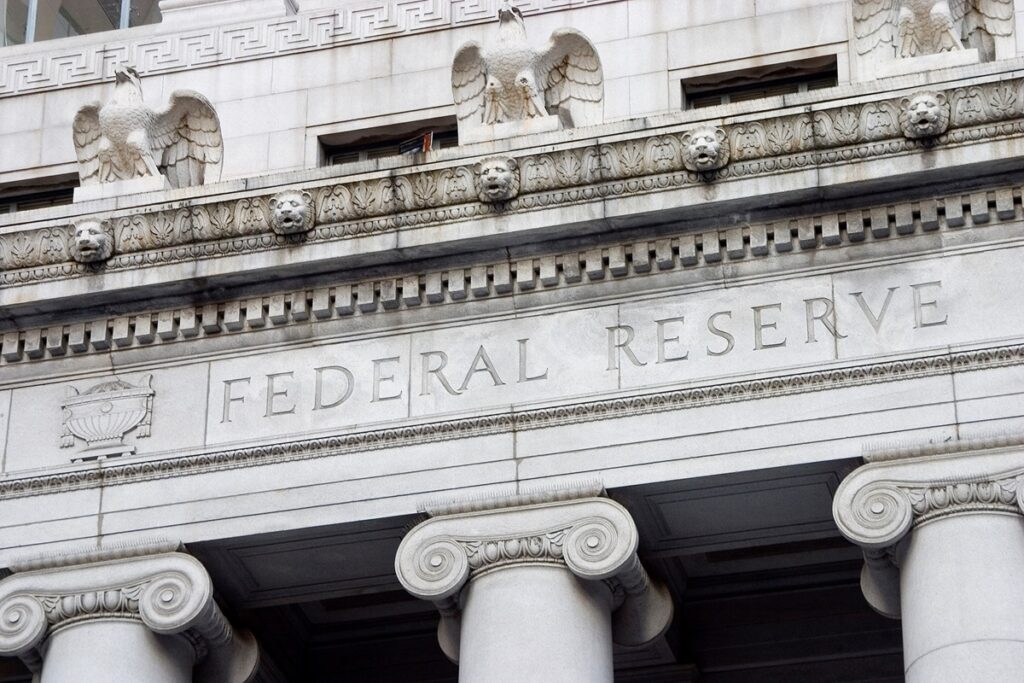For the first time in four years, the Federal Reserve has slashed its benchmark interest rate, a move that will force lower borrowing costs for consumers and businesses.
The rate cut of a full half-point to a new range of 4.75% to 5.0% was announced by Federal Reserve Chair Jerome H. Powell at the conclusion of today’s Federal Open Market Committee (FOMC) meeting. The move by Powell is in response to the fight against inflation, after the Fed kept rates at an all-time 23-year high for more than a year.
The decision by the Fed was nearly unanimous, with opposition coming from Michelle W. Bowman, member of the Board of Governors of the Federal Reserve System, who preferred a smaller 0.25% percentage point cut.
“In assessing the appropriate stance of monetary policy, the Committee will continue to monitor the implications of incoming information for the economic outlook,” said Powell. “The Committee would be prepared to adjust the stance of monetary policy as appropriate if risks emerge that could impede the attainment of the Committee’s goals. The Committee’s assessments will take into account a wide range of information, including readings on labor market conditions, inflation pressures and inflation expectations, and financial and international developments.”
In late July, the FOMC, for the eighth time, decided to leave the nominal interest rate unchanged, keeping it at a 23-year high of 5.50%.
The most aggressive series of rate hikes in history ended in July 2023 when the committee held off on raising rates due to a litany of factors which consisted of 11 straight rate hikes over 15 months. Since the post-pandemic rate hikes began, the FOMC raised rates in March 2022 (+25 points), May 2022 (+50 points), June 2022 (+75 points), August 2022 (+75 points), September (+75 points), November 2022 (+75 points), December 2022 (+50 points), February 2023 (+50 points), March 2023 (+25 points), May 2023 (+25 points), June 2023 (+0 points), July (+25 points), September (+0 points), November (+0 points), December (+0 points), January 2024 (+0 points), March (+0 points), May (+0 points), and June (+0 points). This is equivalent to a rise of 5.00 percentage points in under two years.
The string of rate hikes implemented since the pandemic had been necessary, according to the FOMC, in a move to tamp down inflation, which reached a high of 9.1% in June 2022. The Fed now predicts that inflation will not come down to their 2% target until sometime in 2026.
The Stars Begin to Align
In anticipation of this latest rate cut, mortgage rates have dropped by more than 50 basis points since late July, and a full percentage point off highs reported in May, as the market has begun to shift in advance of the expected rate decline.
Last week, Freddie Mac reported the 30-year, fixed-rate mortgage (FRM) at its lowest point since February 2023, when they averaged 6.20%. A year ago at this time, the 30-year FRM averaged nearly a full percentage point higher at 7.18%.
The drop in rates has propelled a boost in mortgage application volume, as the Mortgage Bankers Association (MBA) reported a 14.2% rise in app volume from one week earlier.
Along with the boost in overall mortgage apps, the refinance share of mortgage activity increased to 51.2% of total applications from 46.7 percent the previous week.
“The fog may finally be clearing on the refinance market, with opportunity beginning to emerge for folks who purchased in recent years with the hope, or even expectation, that they would be able to refinance and improve their payments when the Fed let off the brakes on their rate policy,” added Andy Walden, ICE Vice President of Research and Analysis.
The Industry Responds
Realtor.com Chief Economist Danielle Hale said, “These lower rates have not yet induced a big shift in home buyer and seller activity as home sales still remain sluggish, but they have provided long-awaited relief to homebuyer purchasing power. Monthly mortgage costs are now down to roughly $2,100 from $2,400 in May 2024 and $2,440 in October 2023. Put another way, a buyer who budgeted to buy the typical home in 2023 now has an extra $70,000 in home purchasing power for the same monthly cost, and the boost is even greater in some markets such as those in California.”
Mortgage Bankers Association (MBA) SVP and Chief Economist Mike Fratantoni added: “The FOMC lowered rates by 50 basis points at its September meeting and signaled that this is the first cut in a series that should bring rates down by about 2 percentage points by the end of 2025. Market participants had been divided about how much the Fed would cut at its meeting today, so this decision is likely to spur some rate volatility as investors adjust to this expected path for monetary policy. Governor Bowman dissented from this decision, preferring a 25-basis-point cut, but it seems that the rest of the Committee is more worried about the weakening job market.”
Robert Frick, Corporate Economist with Navy Federal Credit Union, said: “Starts and permits are still lower than levels from earlier this year, but combined with lower mortgage rates and pending Fed rate cuts, today’s data could be the start of a home-building revival. Builders not only will enjoy higher demand for homes as lower mortgage rates make them more affordable, their cost of building will drop and that will expand their margins and encourage more building.”
Voxtur Analytics CEO Ryan Marshall said: “We are now in the beginning of the beginning of the Fed lowering rates. We know that the Fed will continue to cut rates throughout the year to keep the economy as strong as possible, but how far are they willing to go? We think they will keep cutting until rates are hovering at 5%, unless there is a strong economic event, like a major uptick in unemployment. In which case, the Fed will get more aggressive in cutting rates.”
JP Kelly, SVP of Mortgage at MeridianLink, said: “I expect to see at least one more cut, perhaps two, before the end of 2024, with the Fed taking a wait-and-see approach and keeping a close eye on the CPI and PCE reports to confirm timing. While a rate cut will give an immediate boost to purchasing power for potential homebuyers, the pent-up demand, limited available inventory, and high home prices mean that purchasing power increase may not mean much in practical terms. Short of an explosion of homebuilding to relieve inventory constraints, rates dropping to around the mid 5% and negating the lock-in effect is our best hope for spurring real movement in the housing market.”
First American Senior Economist Sam Williamson said, “With mortgage rates expected to gradually decline in the coming months as the Fed begins cutting rates, buyer interest and builder sentiment are likely to improve, potentially leading to improving housing starts and permits in the months ahead, a positive sign for housing supply.”
Max Slyusarchuk, CEO of A&D Mortgage, said: “Much of the Fed’s predicted rate cuts have already been priced in by rates traders, who believe that homebuyers have been on the sidelines waiting for lower rates. We are already seeing benefits for homebuyers who see rates decreasing. Origination volumes at mortgage lenders like A&D Mortgage have already seen growing lending activity, with first half originations in 2023 totaling just over $1 billion vs. over $1.5 billion in 2024, representing a year over year increase of 50%. We are excited about the macroeconomic tail winds provided to mortgage lenders by upcoming Fed monetary policy and look forward to servicing our borrowers as best we can as demand for mortgage financing and re-financing increases into 2025.”
Charles Goodwin, Senior Director of Sales at Kiavi, added: “I’m not expecting much of a change in real estate investor activity in the shorter term. Given the anticipated rate cuts this week, the bond markets and 30-year mortgage rates have already reacted, and those rates have meaningfully come down. However, despite the decrease in mortgage rates, we haven’t seen a big jump in prospective homebuyers coming off the sidelines. In order for real estate investors to become significantly more bullish, we need to see more buyers and sellers enter the market. That being said, I expect the spring of 2025 to be robust for real estate investors if the U.S. jobs market and economy remain steady, and rates keep coming down. Many forecasters say the magic number for mortgage rates to spur buying activity is closer to ~5.5%, so we still have some ways to go.”
Satyan Merchant, SVP, Automotive and Mortgage Business Leader at TransUnion, said: “A reduction of even 25bps in mortgage rates could result in real money staying in the pockets of consumers. For example, U.S. consumers with a mortgage balance of $244,000 who currently have a 7% interest rate could see a potential reduction of almost $50 a month in their monthly mortgage payment. And if the reduction is 50 bps, that same consumer could potentially save almost $100 a month when making that same mortgage payment. And in states where the average mortgage balance is higher, those savings could be even greater. One example is California where the average mortgage balance is more than $430,000. A reduction of 25 bps could save those same consumers about $75 a month and nearly $150 if rates drop 50 bps.”
Greg McBride, CFA, Chief Financial Analyst for Bankrate commented, “Mortgage rates have fallen from a peak of 8% last October to a 19-month low of 6.31% now. But further declines could come at a more modest pace and we’re not going back to the sub-3 percent mortgage rates of 2020 and 2021. While lower mortgage rates will help from an affordability standpoint, other variables like home prices and the availability of homes for sale will be just as important to prospective home buyers.”
Dr. Stephen R. Foerster, CFA, award-winning author, and Professor of Finance at Ivey Business School, said, “There are always winners and losers when there is a change in interest rates. In general, lower rates favor borrowers and hurt lenders and savers. It’s really a case of two sides of the same coin. If you have more money in the form of debt than you do in savings, then on balance you will benefit from rate cuts. But it’s more nuanced (as I explain more below). A lot depends on whether you currently have locked-in borrowing or savings rates.”





